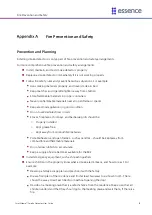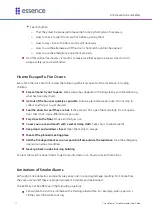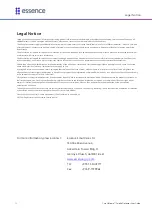
Fire Prevention and Safety
24
Care@Home™ Smoke Detector User Guide
Teach children:
o
That they must be prepared to leave the home by themselves if necessary
o
How to check to see if doors are hot before opening them
o
How to stay close to the floor and crawl if necessary.
o
How to use the alternate exit if the door is hot and should not be opened
o
How to use the emergency equipment properly
Hold fire drills at least every six months to make sure that everyone knows what to do to
escape safely, even small children
How to Escape if a Fire Occurs
Every time there is a fire drill, review the following with all occupants of the residence, including
children:
Stay calm and try not to panic
. Safe escape may depend on thinking clearly and remembering
what has been practiced.
Get out of the house as quickly as possible
. Follow a planned escape route. Do not stop to
collect anything or to get dressed.
Feel the doors to see if they are hot.
If they are not hot, open them carefully. Do not open a
door that is hot. Use a different escape route.
Stay close to the floor
. Smoke and hot gas rise.
Cover your nose and mouth with a wet or damp cloth.
Take short, shallow breaths.
Keep doors and windows closed.
Open them only to escape.
Meet at the planned meeting place
Call the fire department as soon as possible from outside the residence.
Give the emergency
operator a name and address.
Never go back inside a burning building
Contact the local fire department to get more information on how to prevent home fires.
Limitations of Smoke Alarms
Although smoke detectors and alarms play a key role in reducing damage resulting from home fires,
they can only work if they are properly located, installed, and maintained.
The SK2 may not be effective in the following situations:
Fires where the victim is intimate with a flaming initiated fire. For example, when a person’s
clothes catch fire while cooking.



































